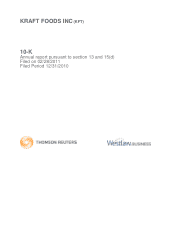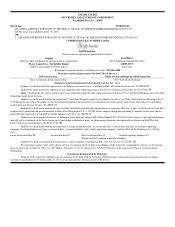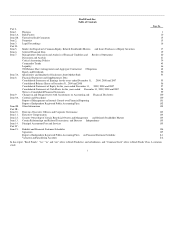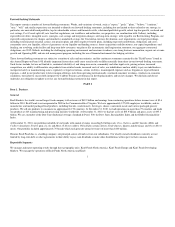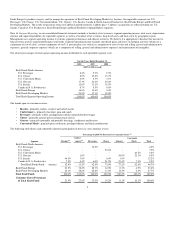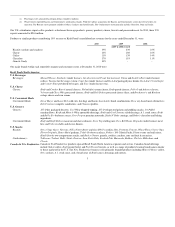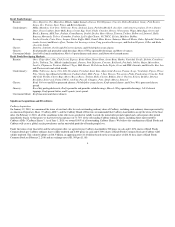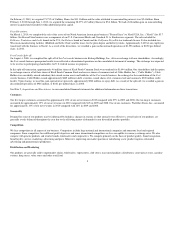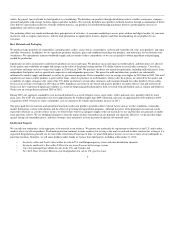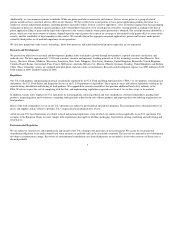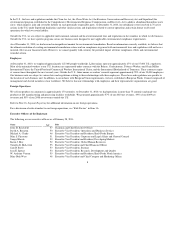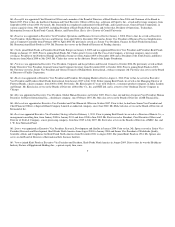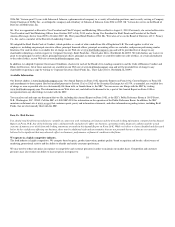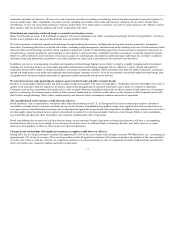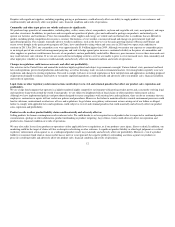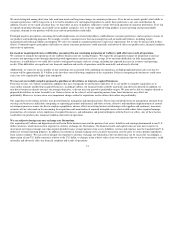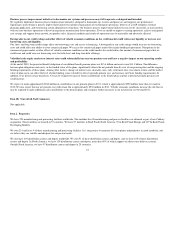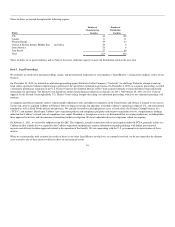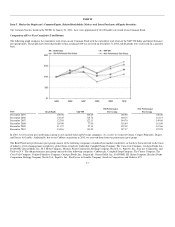Kraft 2010 Annual Report Download - page 10
Download and view the complete annual report
Please find page 10 of the 2010 Kraft annual report below. You can navigate through the pages in the report by either clicking on the pages listed below, or by using the keyword search tool below to find specific information within the annual report.
Additionally, we own numerous patents worldwide. While our patent portfolio is material to our business, the loss of one patent or a group of related
patents would not have a material adverse effect on our business. We have either been issued patents or have patent applications pending that relate to a
number of current and potential products, including products licensed to others. Patents, issued or applied for, cover inventions ranging from basic packaging
techniques to processes relating to specific products and to the products themselves. Our issued patents extend for varying periods according to the date of
patent application filing or grant and the legal term of patents in the various countries where patent protection is obtained. The actual protection afforded by a
patent, which can vary from country to country, depends upon the type of patent, the scope of its coverage as determined by the patent office or courts in the
country, and the availability of legal remedies in the country. We consider that in the aggregate our patent applications, patents and licenses under patents
owned by third parties are of material importance to our operations.
We also have proprietary trade secrets, technology, know-how processes and related intellectual property rights that are not registered.
Research and Development
We pursue four objectives in research and development: product safety and quality; growth through new products; superior consumer satisfaction; and
reduced costs. We have approximately 3,300 food scientists, chemists and engineers working primarily in 15 key technology centers: East Hanover, New
Jersey; Glenview, Illinois; Madison, Wisconsin; Tarrytown, New York; Whippany, New Jersey; Banbury, United Kingdom; Bournville, United Kingdom;
Curitiba, Brazil; Eysins, Switzerland; Paris, France; Melbourne, Australia; Mexico City, Mexico; Munich, Germany; Reading, United Kingdom; and Suzhou,
China. These technology centers are equipped with pilot plants and state-of-the-art instruments. Research and development expense was $583 million in 2010,
$466 million in 2009, and $487 million in 2008.
Regulation
Our U.S. food products and packaging materials are primarily regulated by the U.S. Food and Drug Administration ("FDA") or, for products containing meat
and poultry, the U.S. Food Safety and Inspection Service of the U.S. Department of Agriculture. These agencies enact and enforce regulations relating to the
manufacturing, distribution and labeling of food products. We supported the recently enacted law that provides additional food safety authority to the
FDA. We do not expect the cost of complying with that law, and implementing regulations expected over the next two to three years, to be material.
In addition, various states regulate our U.S. operations by licensing plants, enforcing federal and state standards for selected food products, grading food
products, inspecting plants and warehouses, regulating trade practices related to the sale of dairy products and imposing their own labeling requirements on
food products.
Many of the food commodities we use in our U.S. operations are subject to governmental agricultural programs. These programs have substantial effects on
prices and supplies and are subject to periodic U.S. Congressional and administrative review.
All of our non-U.S. based operations are subject to local and national regulations, some of which are similar to those applicable to our U.S. operations. For
example, in the European Union, we must comply with requirements that apply to labeling, packaging, food content, pricing, marketing and advertising and
related areas.
Environmental Regulation
We are subject to various laws and regulations in and outside of the U.S. relating to the protection of the environment. We accrue for environmental
remediation obligations on an undiscounted basis when amounts are probable and can be reasonably estimated. The accruals are adjusted as new information
develops or circumstances change. Recoveries of environmental remediation costs from third parties are recorded as assets when recovery of those costs is
deemed probable.
7

